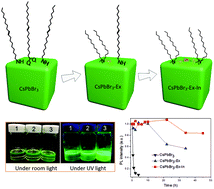Critical role of metal ions in surface engineering toward brightly luminescent and stable cesium lead bromide perovskite quantum dots†
Abstract
The highly dynamic binding ligands on the surface of all-inorganic cesium lead halide perovskite quantum dots (PQDs), which can be easily lost or detached leading to a deterioration in the optical properties and stability, are one of the greatest challenges for the practical storage and application of PQDs. Herein, we report a facile metal ion-assisted ligand surface engineering strategy to synchronously boost the photoluminescence quantum yield and stability of CsPbBr3 PQDs by a sequential short-chain ligand (didodecyl dimethylammonium sulfide, DDA+-S2−) exchange and subsequent metal salt (In(Ac)3) treatment. From detailed characterization of the critical role of the metal ions, these enhancements were found to originate from the promoted ligand capping induced by the metal ions attached on the surface of the PQDs. Considering the shortened ligands and robust surface passivation, the modified CsPbBr3 PQDs exhibit drastically enhanced performance in an electroluminescent device. Our results have provided an insightful understanding of surface ligand engineering for high-quality and stable perovskite QDs and their effective optoelectronic applications.

- This article is part of the themed collections: 2019 Nanoscale HOT Article Collection, Halide Perovskite Nanocrystals and International Year of the Periodic Table : From Pb and Sn Perovskites to the Next Generation


 Please wait while we load your content...
Please wait while we load your content...